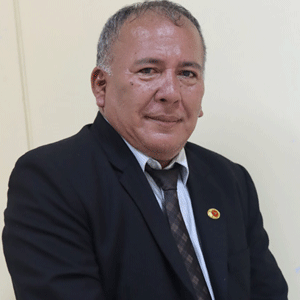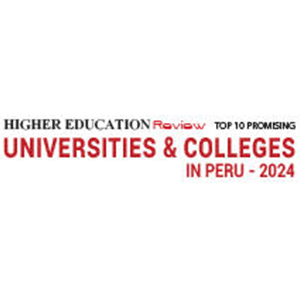
National University Of The Peruvian Amazon: Nurturing Excellence Through Innovation & Collaboration
By Roger Ruiz Paredas, Vice Chancellor of Research
The landscape of higher education in Peru is undergoing rapid transformations to align with the country's evolving societal needs. This transformation encompasses the licensing of universities, the modernization of laboratories, and the enhancement of faculty capabilities through academic mobility. One of the key draws for international students con- sidering studying in Peru is the unparalleled mega biodiversity found in the Peruvian Amazon. At the forefront of this educational shift is the National University of the Peruvian Amazon, a public institution committed to providing top-notch education with a focus on quality and excellence.
The university is dedicated to fulfilling its mission, which remains unchanged: 'To offer humanistic, scientific, and technological professional training to college students with an intercultural approach, respect for Amazonian biodiversity, and social responsibility within the framework of sustainable development.'
This mission underscores the university's commitment to shaping well-rounded pro- fessionals who not only possess a strong academic foundation but also value intercultural perspectives, environmental conservation, and societal well-being. The ultimate goal of National University of the Peruvian Amazon is to contribute significantly to the advancement of the nation, particularly in fostering sustainable development in the Amazon region.
The National University of the Peruvian Amazon faces the challenge of equipping students for the demands of the industry. In response to this, the Peruvian government has officially recognized the establishment and operation of this university's Scientific and Technological Park as a matter of national importance. Presently, the technical and scientific personnel are actively organizing the park's structure. Concurrently, the college is forging strategic partnerships with the industry (chamber of commerce), the regional government, and civil society. This collaborative effort aims to create the essential technological solutions required for the advancement of the Amazon region.
“What sets our courses apart is their distinctive approach: a curriculum designed based on an educational model tailored to the tropics and international competitions. This ensures that students not only develop but also showcase exceptional abilities and skills on both national and international platforms”, speaks Roger Ruiz Paredes, Vice Chancellor of Research, National University of the Peruvian Amazon.
One of the key assets of the National University of the Peruvian Amazon lies in its extensive experimental areas, the largest in the country, hosting national and international training centers, research facilities, and laboratories. Notably, recent acquisitions include a Biotechnology laboratory, a natural resources research center with well-equipped laboratories and skilled personnel, the laboratory of the Tropical Medicine Institute, the UNAP Research Institute, and specialized laboratories for disciplines such as health sciences, engineering, and social sciences.
A significant portion of National University of the Peruvian Amazon’s teaching staff has pursued education abroad, bringing a wealth of international and local experience to the university. “Academic mobility plays a crucial role in our success, supported by a cadre of national and international consultants. Presently, our focus is directed towards augmenting the pool of qualified researchers at the national level and concurrently increasing the number of international publications in peer-reviewed journals”, adds Roger Ruiz Parede.
Essential for the progress of the National University of the Peruvian Amazon, national and international scholarships are facilitated through programs such as Scholarship 18, focusing on undergraduate students, and the President Scholarship, dedicated to the advanced training of master's and doctoral candidates. Additionally, Concytec provides financial support for presentations, internships, and research initiatives, among others.
Various workshops, seminars, and training activities form a crucial part of the academic landscape. Students actively engage in diverse scientific conferences held in Peru, with a notable emphasis on internships conducted within the extensive Peruvian Network of Universities (both national and private) and collaborating educational institutions.
These endeavors are guided by specific agreements and frameworks established through research collaborations. Furthermore, international agreements play a pivotal role, primarily directed towards fostering research initiatives.
There exists a robust connection between the industry and the National University of the Peruvian Amazon, marked by a strategic alliance among the faculties of engineering, business, and economic and business sciences. This collaboration aims to enhance technological solutions for production, thereby increasing value addition.
Simultaneously, it plays a vital role in reinforcing the practical experiences of students and aligning academic training with the industrial requisites crucial for mitigating deforestation challenges faced by the National University of the Peruvian Amazon.
The trajectory of the National University of the Peruvian Amazon is charted towards updating its institutional strategic plan. This involves fortifying the capacities within the administrative and teaching segments, fostering the development of the business incubator, operationalizing the Scientific and Technological Park in the Peruvian Amazon, promoting the utilization of existing experimental centers, and actively increasing academic mobility.
The university is dedicated to fulfilling its mission, which remains unchanged: 'To offer humanistic, scientific, and technological professional training to college students with an intercultural approach, respect for Amazonian biodiversity, and social responsibility within the framework of sustainable development.'
This mission underscores the university's commitment to shaping well-rounded pro- fessionals who not only possess a strong academic foundation but also value intercultural perspectives, environmental conservation, and societal well-being. The ultimate goal of National University of the Peruvian Amazon is to contribute significantly to the advancement of the nation, particularly in fostering sustainable development in the Amazon region.
Meeting Industry Demands with Specialized Education
The National University of the Peruvian Amazon faces the challenge of equipping students for the demands of the industry. In response to this, the Peruvian government has officially recognized the establishment and operation of this university's Scientific and Technological Park as a matter of national importance. Presently, the technical and scientific personnel are actively organizing the park's structure. Concurrently, the college is forging strategic partnerships with the industry (chamber of commerce), the regional government, and civil society. This collaborative effort aims to create the essential technological solutions required for the advancement of the Amazon region.
“What sets our courses apart is their distinctive approach: a curriculum designed based on an educational model tailored to the tropics and international competitions. This ensures that students not only develop but also showcase exceptional abilities and skills on both national and international platforms”, speaks Roger Ruiz Paredes, Vice Chancellor of Research, National University of the Peruvian Amazon.
"The ultimate goal of National University of the Peruvian Amazon is to contribute significantly to the advancement of the nation, particularly in fostering sustainable development in the Amazon region"
Cutting-Edge Facilities & International Academic Community
One of the key assets of the National University of the Peruvian Amazon lies in its extensive experimental areas, the largest in the country, hosting national and international training centers, research facilities, and laboratories. Notably, recent acquisitions include a Biotechnology laboratory, a natural resources research center with well-equipped laboratories and skilled personnel, the laboratory of the Tropical Medicine Institute, the UNAP Research Institute, and specialized laboratories for disciplines such as health sciences, engineering, and social sciences.
A significant portion of National University of the Peruvian Amazon’s teaching staff has pursued education abroad, bringing a wealth of international and local experience to the university. “Academic mobility plays a crucial role in our success, supported by a cadre of national and international consultants. Presently, our focus is directed towards augmenting the pool of qualified researchers at the national level and concurrently increasing the number of international publications in peer-reviewed journals”, adds Roger Ruiz Parede.
Scholarships & Collaborative Initiatives
Essential for the progress of the National University of the Peruvian Amazon, national and international scholarships are facilitated through programs such as Scholarship 18, focusing on undergraduate students, and the President Scholarship, dedicated to the advanced training of master's and doctoral candidates. Additionally, Concytec provides financial support for presentations, internships, and research initiatives, among others.
Various workshops, seminars, and training activities form a crucial part of the academic landscape. Students actively engage in diverse scientific conferences held in Peru, with a notable emphasis on internships conducted within the extensive Peruvian Network of Universities (both national and private) and collaborating educational institutions.
These endeavors are guided by specific agreements and frameworks established through research collaborations. Furthermore, international agreements play a pivotal role, primarily directed towards fostering research initiatives.
Path Ahead
There exists a robust connection between the industry and the National University of the Peruvian Amazon, marked by a strategic alliance among the faculties of engineering, business, and economic and business sciences. This collaboration aims to enhance technological solutions for production, thereby increasing value addition.
Simultaneously, it plays a vital role in reinforcing the practical experiences of students and aligning academic training with the industrial requisites crucial for mitigating deforestation challenges faced by the National University of the Peruvian Amazon.
The trajectory of the National University of the Peruvian Amazon is charted towards updating its institutional strategic plan. This involves fortifying the capacities within the administrative and teaching segments, fostering the development of the business incubator, operationalizing the Scientific and Technological Park in the Peruvian Amazon, promoting the utilization of existing experimental centers, and actively increasing academic mobility.


